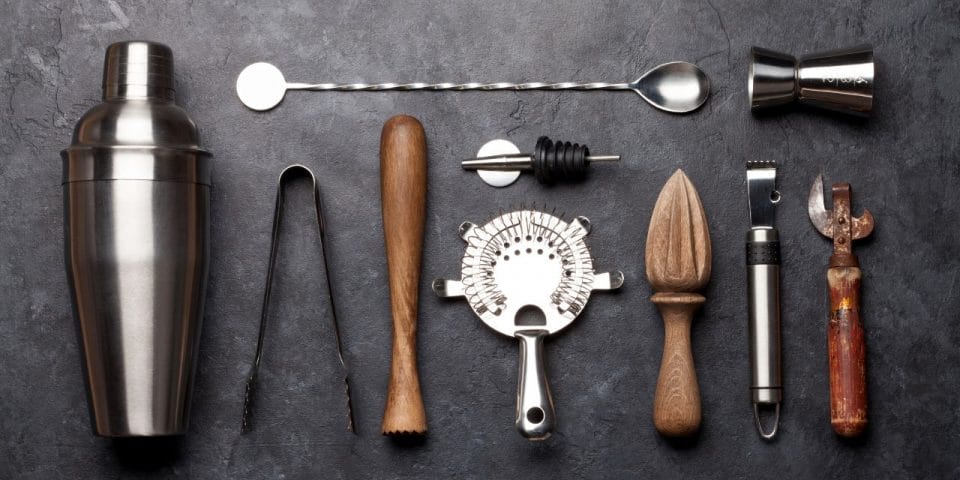When you’re behind the bar, your tools are your best allies. Whether you’re mixing up cocktails or pouring spirits, the way your tools perform can really impact the drinks you serve. Good tools not only help you create delicious beverages but also enhance your guests’ overall experience.
In this article, we’ll explore the best practices for maintaining bar tools to ensure they perform at their best and last for years to come. From inspection routines to effective storage and cleaning techniques, we’ll cover essential practices that every Bartender should adopt.
Key Bar Tools To Keep in Shape
To maintain your bar tools effectively, it’s essential to know which ones need your attention. Here’s a rundown of the key bar tools you’ll be using regularly:
- Cocktail shaker: Used for shaking and mixing a variety of cocktails, ensuring that flavors blend seamlessly.
- Strainer: Helps separate solid ingredients from liquids when pouring, giving drinks a smooth finish.
- Jigger: A measuring tool that allows for precise pouring of spirits and other ingredients, crucial for maintaining drink consistency.
- Muddler: Perfect for crushing herbs, fruits or sugar, releasing their flavors to enhance your cocktails.
- Bar spoon: This long-handled spoon is designed specifically for stirring, allowing you to mix drinks effectively.
- Bottle opener: A handy tool for opening bottles, particularly for beer and soda, making sure you’re always ready to serve.
- Corkscrew: Essential for effortlessly opening wine bottles, ensuring easy access to your wine selection.
- Zester: Used for creating garnishes from citrus fruits, adding a final touch to your cocktails.
- Peeler: Perfect for slicing fruits and vegetables, allowing for creative garnishes that elevate your drink presentation.
- Ice scoop: For serving ice from the bin to the glass without making a mess.
- Channel knife: A versatile tool for creating intricate twists and garnishes from citrus peels, adding flair to your cocktails.
- Mixing glass: A classic vessel used for stirring cocktails, it is a must-have for any serious Bartender.
- Fine mesh strainer: Ideal for filtering out small particles when serving cocktails, ensuring a clean pour.
- Bar mat: A practical element for catching spills and keeping your workspace tidy, enhancing overall efficiency.
8 Best Practices for Maintaining Bar Tools
Maintaining your bar tools is essential for ensuring they perform at their best. Here’s a look at some key practices to help you keep everything in top condition.
1. Regular inspections
Regular inspections play a crucial role in identifying potential issues before they escalate. Conducting routine checks can help ensure that your tools are in good working condition.
Here are the signs to look for:
- Wear and tear: Check for rust, dents or cracks that could affect performance.
- Functionality: Ensure that moving parts, like the mechanism in a corkscrew, operate smoothly.
- Cleaning residue: Look for leftover residue or stains that could contaminate future drinks.
Set a schedule for inspections that works for you and your team — whether daily, weekly or monthly — to keep everything in top shape.
2. Proper usage techniques
Proper usage techniques can significantly extend the life of your bar tools. Each tool has specific ways to be used effectively that minimize wear.
For example, when using a cocktail shaker, ensure that you’re shaking with the proper technique to avoid damaging the tool’s seal. Encourage your team to spend time perfecting their methods, as consistent technique reduces the risk of unnecessary wear and tear.
To help illustrate the correct method, check out the video below:
3. Cleaning bar tools
Keeping your bar tools clean is essential for both hygiene and performance. Proper cleaning prevents contamination and helps maintain the integrity of your equipment, ensuring that each drink you serve is fresh and flavorful.
Here are some effective cleaning tips to keep your bar tools in top shape:
- Use gentle detergents for hand washing and avoid harsh chemicals that could damage tools.
- Rinse thoroughly after cleaning to remove any soap residue.
- Air dry tools completely before storing to prevent moisture buildup, which can lead to rust and other issues.
4. Proper storage
Storing your tools correctly is essential to prevent damage and keep them from getting lost.
Using tool holders, racks or designated drawers can help you keep everything organized.
By keeping tools off the counter and in their specific places, you not only protect their condition but also improve efficiency during busy service.
5. Understanding different materials
Understanding the different materials used in bar tools can also help with maintenance. Common materials include stainless steel, glass and plastic, each with its own set of pros and cons.
- Stainless steel: Durable and resistant to rust, but should still be inspected regularly for scratches and wear.
- Glass: Elegant but fragile; handle with care during both use and cleaning.
- Plastic: Lightweight and durable, but may warp or stain over time.
6. Training and continuing education
Encouraging ongoing training for your team is vital. Workshops or classes focusing on tool maintenance and proper usage not only enhance skills but also foster a deeper appreciation for the craft.
Sharing experiences and insights among staff promotes a culture of care that benefits both the Bartenders and guests.
Knowing When To Replace Tools
As a Bartender, it’s important to be aware that some tools will inevitably show signs of wear over time that can’t be fixed. Recognizing when it’s time to upgrade or replace these tools is an essential aspect of effective maintenance.
Here are some clear signs that it may be time to invest in new tools:
- Visible damage: Look for cracks, dents or rust that may impact the tool’s performance.
- Decreased usability: If a tool becomes increasingly difficult to use, it might be time to consider a replacement.
- Declining drink quality: Customer feedback pointing to changes in the quality of drinks can signal that a tool is no longer functioning optimally.
Conclusion
Incorporating the best practices for maintaining bar tools into your routine is essential for any Bartender dedicated to their craft. Proper inspections, usage techniques, cleaning, storage and ongoing education all contribute to extending the life of your tools and ensuring the drinks you serve are of the highest quality.
To further support your journey as a Bartender, consider utilizing resources like OysterLink. OysterLink offers a wealth of information tailored specifically for Bartenders, including career advice, industry insights and top-paying jobs.
Best Practices for Maintaining Bar Tools: FAQ
Many Bartenders may use harsh chemicals or neglect to rinse thoroughly, which can damage tools over time. It’s also important to avoid soaking certain tools, like wooden muddlers, as this can warp them.
Delicate tools should be stored in a dedicated area with padding to prevent breakage. Consider using dividers or nests specifically designed to hold fragile barware safely.
No, different materials require specific care. For instance, stainless steel can handle more robust cleaning solutions, while glass tools may need gentler treatment to avoid scratches.
In addition to regular cleaning and proper storage, using tools correctly, protecting them from extreme temperatures,and regularly inspecting them for wear can significantly prolong their life.
If you find that a tool is damaged beyond repair, it’s best to dispose of it responsibly. You might want to consider replacing it with a high-quality version that suits your needs. Investing in durable tools can be beneficial in the long run, as it tends to save you money and ensure better performance.

Written by Sasha Vidakovic
Sasha is an experienced writer and editor with over eight years in the industry. Holding a master’s degree in English and Russian, she brings both linguistic expertise and creativity to her role at OysterLink. When she’s not working, she enjoys exploring new destinations, with travel being a key part of both her personal and professional growth.

Reviewed by Marcy Miniano
Marcy is an editor and writer with a background in public relations and brand marketing. Throughout her nearly decade-long career, she has honed her skills in crafting content and helping build brands across various industries — including restaurant and hospitality, travel, tech, fashion and entertainment.




